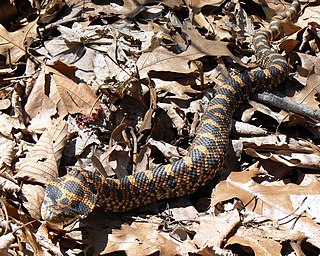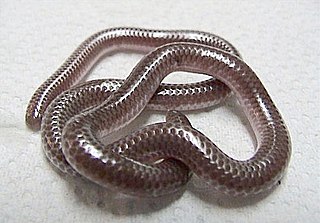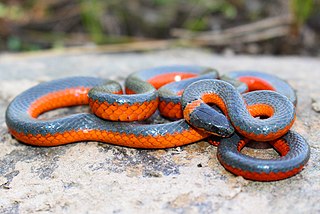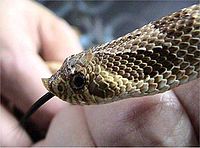
Kingsnakes are colubrid New World members of the genus Lampropeltis, which includes 26 species. Among these, about 45 subspecies are recognized. They are nonvenomous and ophiophagous in diet.

Hognose snake is a common name for several unrelated species of snakes with upturned snouts, classified in two colubrid snake families and one pseudoxyrhophiid snake family.

Rena humilis, known commonly as the western blind snake, the western slender blind snake, or the western threadsnake, is a species of snake in the family Leptotyphlopidae. The species is endemic to the southwestern United States and northern Mexico. Six subspecies are currently recognized, including the nominate subspecies described here.

Rena dulcis, also known commonly as the Texas blind snake, the Texas slender blind snake, or the Texas threadsnake, is a species of snake in the family Leptotyphlopidae. The species is endemic to the Southwestern United States and adjacent northern Mexico. Three subspecies are currently recognized, including the nominate subspecies described here.

The gray-banded kingsnake, sometimes referred to as the alterna or the Davis Mountain king snake, is a species of nonvenomous snake in the family Colubridae. The species is endemic to the southwestern United States and adjacent Mexico. Some sources list two distinct subspecies of Lampropeltis alterna, as L. a. alterna and L. a. blairi differentiated by patterning and locale, but research has shown them to be color morphs of the same species.

Pantherophis vulpinus, commonly known as the foxsnake or the eastern fox snake, is a species of nonvenomous rat snake in the family Colubridae. The species is native to North America.

Tropidoclonion is a genus of snake in the subfamily Natricinae of the family Colubridae. The genus is monotypic, containing the sole species Tropidoclonion lineatum, commonly known as the lined snake. The species is endemic to North America.

The long-nosed snake is a species of nonvenomous snake in the family Colubridae. The species is endemic to North America. It has two recognized subspecies. The other species in the genus were previously considered subspecies.

Heterodon is a genus of harmless colubrid snakes endemic to North America. They are stout with upturned snouts and are perhaps best known for their characteristic threat displays. Three species are currently recognized. Members of the genus are commonly known as hognose snakes, hog-nosed snakes, North American hog-nosed snakes, and colloquially puff adders.

Diadophis punctatus, commonly known as the ring-necked snake or ringneck snake, is a harmless species of colubrid snake found throughout much of the United States, central Mexico, and south-eastern Canada. Ring-necked snakes are secretive, nocturnal snakes, so are rarely seen during the day time. They are best known for their unique defense posture of curling up their tails, exposing their bright red-orange posterior, ventral surface when threatened.

Salvadora is a genus of colubrid snakes commonly called patchnose snakes or patch-nosed snakes, which are endemic to the western United States and Mexico. They are characterized by having a distinctive scale on the tip of the snout.

The eastern hog-nosed snake, is a species of mildly venomous rear-fanged snake in the family Colubridae. The species is endemic to North America. There are no subspecies that are recognized as being valid. This species prefers habitats with sandy soils and a combination of grass fields and forest edges. They come in many different colorations and have the identifiable upturned "snout". They can be found in captivity but are a more difficult species to keep due to a specialized diet of toads.

Holbrookia maculata, commonly known as the lesser earless lizard, is a species of lizard in the family Phrynosomatidae. The species is native to the southwestern and central United States and northern Mexico. There are eight recognized subspecies.

The western ground snake is a species of small, harmless colubrid snake. The species is endemic to North America. Its patterning and coloration can vary widely, even within the same geographic region. Another common name is miter snake referring to the head marking which suggests a bishop's miter; the synonym "episcopus " is a similar allusion.

Sistrurus tergeminus edwardsii, also known as the desert massasauga, is a subspecies of venomous pit viper in the family Viperidae. The subspecies is endemic to the Southwestern United States and northern Mexico. In places, its range overlaps that of S. t. tergeminus, and intergrading of the two subspecies is known.
Howard Kay Gloyd was an American herpetologist who is credited with describing several new species and subspecies of reptiles, such as the Florida cottonmouth, Agkistrodon piscivorus conanti.

The smooth earth snake is a species of nonvenomous natricine colubrid snake native to the eastern half of the United States.

The checkered garter snake is a species of garter snake in the subfamily Natricinae of the family Colubridae. The species is endemic to the southwestern United States, Mexico, and Central America.

Heterodon simus, commonly known as the southern hog-nosed snake, is a harmless snake species endemic to the southeastern United States. No subspecies are currently recognized.

The striped whipsnake is a species of nonvenomous snake in the family Colubridae. It is closely related to the California whipsnake. The striped whipsnake is native to the western United States and adjacent northern Mexico.





















